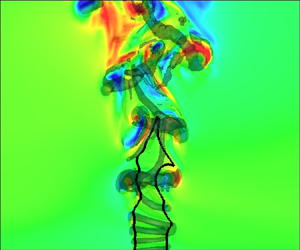Article contents
Response of supercritical round jets to various excitation modes
Published online by Cambridge University Press: 15 March 2021
Abstract

In this study, the response of a supercritical round jet to various excitation modes including varicose, helical, flapping, dual varicose/helical and dual varicose/flapping is studied using large eddy simulations. A translation method is proposed to enhance the accuracy of the equation-of-state and transport correlations. Results show that the excitations, especially the dual modes and the varicose mode (when the forcing frequency matches the preferred mode in the potential core), considerably increase the turbulent mixing, the pitch distance and the penetration depth of the coherent structures as compared with the unexcited case. However, the excitations, especially the dual modes, de-energize the coherent structures and reduce the degree of three-dimensionality of the coherent structures. The excitations reduce the potential core length drastically, especially under the flapping and the dual mode excitations. Analyses show that the dual varicose/flapping mode excitations have the highest impacts on the jet development and the cross-section shape as compared with the other modes. Moreover, the dual varicose/flapping excitations have the highest impact on the large-scale turbulent mixing. However, the small-scale turbulent mixing is at the maximum value, when the supercritical jet is stimulated by the dual varicose/flapping mode excitations with the varicose-to-flapping frequency ratio of 2. The cross-correlations between the density fluctuations and the imposed perturbations indicate that the impact of the excitations on the turbulent diffusion is at the maximum value at the potential core breakdown location, while the correlation diminishes at the other locations.
- Type
- JFM Papers
- Information
- Copyright
- © The Author(s), 2021. Published by Cambridge University Press
References
REFERENCES
- 5
- Cited by



